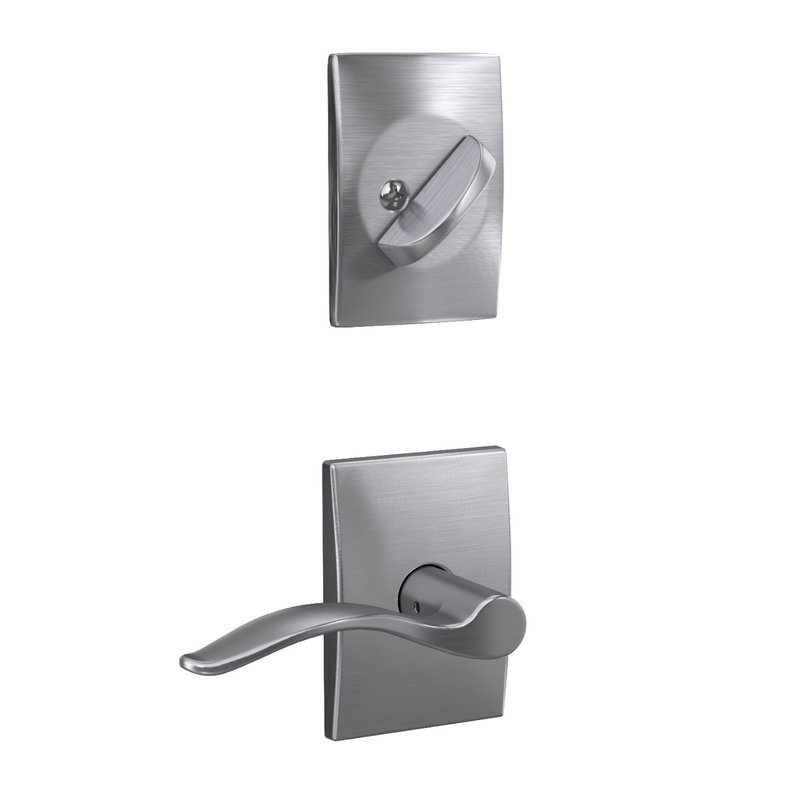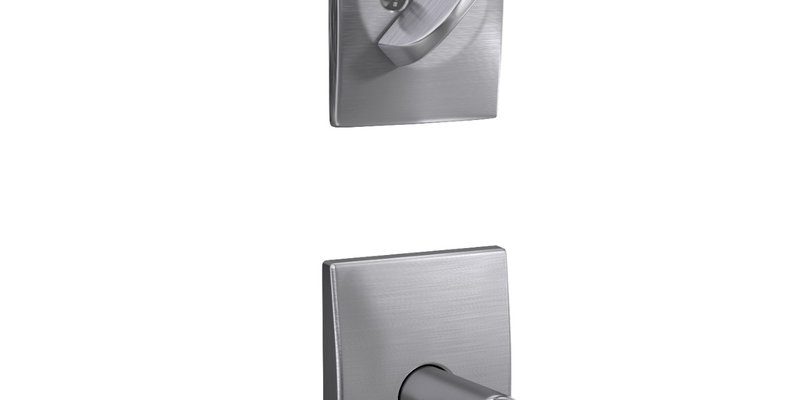
You might be nodding along, thinking, “Okay, but what actually *makes* a handleset last?” Let me explain. When you press the thumb latch, turn the knob, or operate the deadbolt from inside, you’re putting those interior components to work. Over time, cheap or weak materials inside the lock can bend, rust, or just break. The brand of your handleset—whether it’s a Kwikset, Schlage, Yale, or another—does impact the design. But the real secret sauce is the material choice. Picking the right one can mean years of smooth operation, fewer headaches, and a lot less troubleshooting.
Why Material Choice Matters for Interior Handleset Components
When it comes to handlesets, most people focus on the outside finish—maybe shiny brass or sleek matte black. But the real durability test happens inside the lock. That’s where all the code, sync, and reset mechanisms live. Those moving parts take a beating every day. If they’re not made from sturdy materials, you’ll end up with sticking, slipping, or even parts wearing out before you’re ready to replace your whole remote (uh, handleset).
Here’s the thing: The inside of a lock isn’t just one chunk of metal. It’s a tangle of springs, pins, levers, and plates. Each piece is only as durable as what it’s made of. If your lock starts acting up—maybe the battery dies in a smart lock or you need to reset it because it won’t sync with your home automation—it’s almost always the interior components that are to blame. Choosing handlesets made with strong, corrosion-resistant interior parts cuts down on these kinds of problems.
So, if you want a lock that keeps working (and doesn’t keep you locked out), material matters—a lot. Whether you’re troubleshooting an existing lock or shopping for a new one, understanding these components helps you make the right call.
Brass: The Gold Standard for Strength and Resistance
Brass has been the go-to handleset material for generations, and honestly, it’s easy to see why. This copper-and-zinc alloy doesn’t just look fancy—it’s the workhorse of the industry for both interior and exterior parts. When it comes to interior components, brass just doesn’t quit.
- Corrosion resistance: Handleset interiors are exposed to moisture and grime every time the door opens. Brass shrugs off rust, so you rarely see the pitting or flaking that comes with lesser materials.
- Workability: Brass is soft enough for manufacturers to shape precisely, so you get those satisfying clicks and smooth motions. That means easier code changes if you’re dealing with a smart lock or swapping out a remote deadbolt.
- Self-lubricating properties: Brass doesn’t grab onto dirt or stick like some metals. The pins inside a cylinder, for example, glide over each other, so you’ll spend less time troubleshooting stiff locks.
Of course, not all brass is created equal. Lower-tier, thin-plated “brass” parts might look the part but wear out faster. Top brands usually use solid brass for their high-end models—so if you spot “solid brass construction” on a Schlage or Yale box, you’re on the right track.
Stainless Steel: Best for High-Traffic and Humid Areas
You might be wondering why so many commercial handlesets lean heavily on stainless steel for their interior guts. The answer’s pretty simple: stainless steel is nearly indestructible in tough conditions. It’s the superhero of lock materials, especially if your door sees a lot of action—or if the environment is less than friendly.
- Ultimate corrosion resistance: Unlike regular steel, stainless contains chromium, which forms a protective skin that shrugs off moisture. If your door leads to a steamy bathroom, a pool deck, or anywhere with high humidity, stainless interiors are your friend.
- Strength under pressure: The pins, springs, and levers made from stainless don’t deform under repeated use. So whether your kid slams the door or you lock up a dozen times a day, these parts stand up to the challenge.
- Low maintenance: No need to baby these components with special oils or coatings. Stainless steel resists grime and keeps moving smoothly, which means less troubleshooting and smoother code entry on electronic handlesets.
Some brands mix stainless with brass for a blend of durability and affordability. You’ll usually spot all-stainless interiors in higher-end, heavy-duty models—think commercial buildings or rental properties where failures just aren’t an option.
Zinc Alloy: Affordable and Reasonably Durable
Let’s be real—not everyone wants to spend top dollar on a handleset. That’s where zinc alloys (sometimes called “zamac”) come in. These are usually found in budget or midrange models, striking a balance between cost and performance.
- Cost-effective: Zinc costs less than solid brass or stainless. If you’re replacing several doors in a rental or a fixer-upper, this can save you a bundle.
- Decent strength: For low-traffic interior doors, zinc holds up well. You won’t get the decades-long durability of brass or stainless, but most people won’t notice the difference for a few years.
- Susceptible to corrosion: Here’s the trade-off—zinc alloys can corrode if exposed to water or salty air. If your lock is facing an exterior door or a humid basement, you might see some pitting or sticking over time. That can mean more troubleshooting and reset headaches down the road.
Many big-box brands use zinc for the “hidden” interior bits but upgrade to stainless or brass for the critical locking parts. If you’re considering a zinc-alloy handleset, look for brands that back up their products with a solid warranty.
Plastic Components: Where They Work (and Where They Don’t)
Plastic gets a bad rap in door hardware, and honestly, sometimes that’s fair. No one wants a lock that feels flimsy or cracks after a few months. But there *are* places where plastic interiors make sense, especially in non-load-bearing parts.
- Cost and weight: Plastic makes locks lighter and cheaper. For interior closet doors or rooms that don’t see much use, that’s sometimes all you need.
- Wear points: The trouble starts when plastic parts are used in spots that take real force—like levers, latch bolts, or deadbolt actuators. That’s when things can snap, warp, or just stop syncing properly with high-security features.
- Used in smart locks: Some modern remotes rely on plastic for battery housings and electronics mounts. As long as main moving parts aren’t plastic, this can be fine. Just be ready for more frequent troubleshooting if the door takes a lot of use (or abuse).
If you’re shopping for interior handlesets for closets or spares, plastic works in a pinch. For entry doors, though, you’ll want metal—every time.
Comparing Common Materials: A Side-by-Side Look
Let’s put these materials head-to-head. Here’s how the most common handleset interior materials compare when it comes to durability, cost, and best use cases:
| Material | Durability | Corrosion Resistance | Typical Use | Cost |
| Brass | Excellent | Very high | Premium home, high-security locks | High |
| Stainless Steel | Excellent | Very high | Commercial, high-traffic doors | High |
| Zinc Alloy | Good | Moderate | Budget-friendly, interior doors | Moderate |
| Plastic | Poor to Fair | Varies | Closets, electronics housing | Low |
Insight: If your lock is giving you trouble—like sticky operation, code errors, or dead batteries—it’s usually an internal material issue, not just bad luck.
Case Study: How Kwikset and Schlage Handle Interior Components
Let’s zoom in on two household names in door hardware—Kwikset and Schlage. Both brands get plenty of love (and complaints) online, and their choices for handleset interior components tell you a lot about what you can expect for durability.
- Kwikset: In their high-end models, Kwikset leans into solid brass locking components, especially in their SmartKey lines. For budget or contractor packs, you’ll find more zinc and even plastic on the interiors, especially on non-critical parts. That means premium models last longer and need less troubleshooting.
- Schlage: Schlage takes pride in using heavy-duty brass and stainless steel, particularly in their residential deadbolts and grade-1 handlesets. Lower-cost models still use mixed metals but tend to avoid plastic on moving parts. That’s why Schlage locks often feel smoother and stay in sync after years of use.
So, what’s the takeaway? Both brands offer a range—from “good enough” for spare bedrooms to “built like a tank” for front doors. It all comes down to what’s hiding inside.
Choosing the Right Handleset for Your Needs
Now that you know what goes into a durable handleset, the next question is—what’s right for you? You might be upgrading for code access, syncing with a home system, or just tired of a sticky old lock.
- Front or back entry doors: Go for solid brass or stainless steel interiors. It’s worth spending a little more now instead of troubleshooting problems or replacing remotes (locks) later.
- Interior doors or closets: Zinc alloys or even some plastic are fine for low-use spots. Just don’t expect decades of smooth performance.
- Smart locks: Make sure the moving bits—latch, deadbolt, actuator—are metal. Cheap models cut corners here, leading to battery drain or reset issues if parts stick.
- High-humidity or coastal homes: Stainless steel is your best friend. Brass is close behind, as long as it’s solid and not just plated.
If you’re not sure, check the packaging or dig into the brand’s specs. Manufacturers usually spell out if the interior is brass, stainless, or a zinc alloy. When in doubt, opt for more metal and less plastic.
Final Thoughts: Invest in Lasting Performance
A sturdy handleset isn’t just about a good-looking exterior—it’s what’s inside that counts. The best materials for handleset interior components—brass and stainless steel—give you a tough, worry-free lock that stands up to years of daily use. Zinc alloys work for less demanding jobs, while plastic is best left to low-traffic doors or non-critical electronics.
Honestly, a little attention to those hidden parts pays off big. You’ll deal with less troubleshooting, fewer code or battery issues, and you won’t get stuck fixing or replacing your handleset every couple of years. At the end of the day, choosing the right material comes down to matching durability with where and how your lock will be used. And once you nail that, your door’s handshake will stay strong for years to come.
